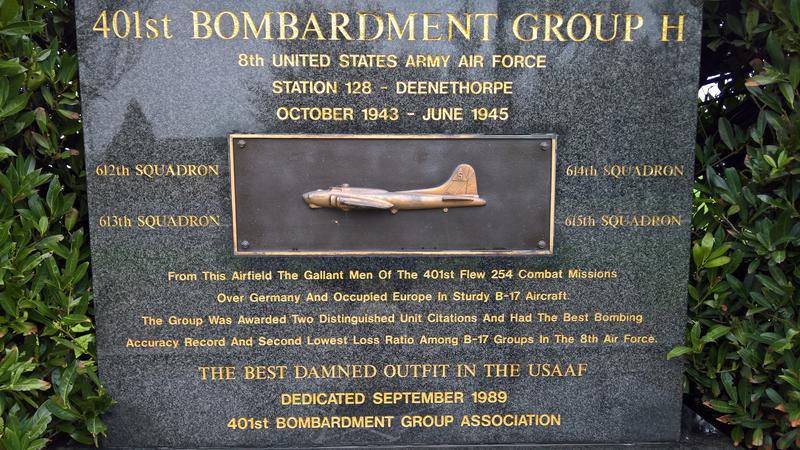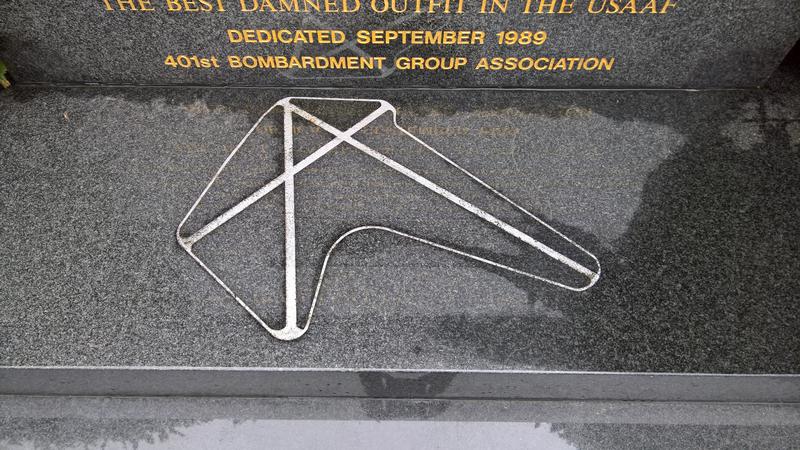401st Bombardment Group (H) Memorial
Details:
On the north side of the road.
A tablet with a polished base of the same material, inscribed in English in gold lettering. A plaque with an image of a B-17 is secured to the front of the tablet. The memorial is set in an area of gravel with a low chain hanging in front of it, held up by small pillars. On the base of the tablet, a plan of the airfield could be seen. The memorial was unveiled on September 16, 1989, and was dedicated to the men of 401st Bombardment Group who were stationed at RAF Deenethorpe during World War II.
Deenethorpe was constructed in 1943 and was allocated to the United States Army Air Forces Eighth Air Force. It was assigned USAAF designation Station 128.
With the opening of the airfield in October 1943, the 401st Bombardment Group (Heavy), arrived from Great Falls AAB, Montana, in November. The 401st was assigned to the 94th Combat Bombardment Wing of the 1st Bombardment Division. Its tail code was Triangle-S.
The 401st Bomb Group consisted of the following operational squadrons flying Boeing B-17 Flying Fortress :
- 612th Bombardment Squadron (SC)
- 613th Bombardment Squadron (IN)
- 614th Bombardment Squadron (IW)
- 615th Bombardment Squadron (IY)
The 401st BG operated chiefly against strategic targets, bombing industries, submarine facilities, shipyards, missile sites, marshaling yards, and airfields; beginning in October 1944, concentrated on oil reserves. The Group received a Distinguished Unit Citation for striking telling blows against German aircraft production on 11 January and 20 February 1944.
In addition to strategic missions, group operations included attacks on transportation, airfields, and fortifications prior to the Normandy invasion and on D-Day, June 1944; support for ground operations during the breakthrough at Saint-Lô in July, the siege of Brest in August, and the airborne attack on the Netherlands in September 1944.
The Group flew missions against enemy forces during the Battle of the Bulge, December 1944 - January 1945, by assaulting transportation targets and communications centers in the battle area; and support for the airborne attack across the Rhine in March 1945.
The worst accident occurred on 5 December 1943 when a Fortress that failed to get off the ground careered over farmland and came to rest after crashing into a cottage on the edge of Deenethorpe village. The surviving members of the crew just had time to evacuate the wreckage and warn the villagers of the imminent explosion of the bomb load before it detonated damaging many houses in the village. The blast was felt in Kettering nine miles away.
After V-E Day, the group departed from Deenethorpe in August 1945 and returned to Sioux Falls AAF where the unit was inactivated, personnel demobilized and B-17 aircraft sent to storage.
The 401st Bombardment Group had flown 255 combat missions from Deenethorpe airfield.
After the war, Deenethorpe was used as an RAF Recruiting Centre, and later for several years, the control tower was used as a lookout post by the local Royal Observer Corps. It was finally sold in 1963 and largely returned to agriculture. Part of the old main runway is now used as a private airstrip.
Source of information: Imperial War Museum War Memorials Register, en.wikipedia.org
Source of images: Imperial War Museum War Memorials Register
Monument Text:
TO REMEMBER THE
401ST BOMBARDMENT GROUP H
8TH UNITED STATES ARMY AIR FORCE
STATION 128 - DEENETHORPE
OCTOBER 1943 - JUNE 1945
612th SQUADRON
614th SQUADRON |
| 613th SQUADRON
615th SQUADRON |
From This Airfield The Gallant Men Of The 401st Flew 254 Combat Missions
Over Germany And Occupied Europe In Sturdy B-17 Aircraft.
The Group Was Awarded Two Distinguished Unit Citations And Had The Best Bombing
Accuracy Record And Second Lowest Loss Ratio Among B-17 Groups In The 8th Air Force.
THE BEST DAMNED OUTFIT IN THE USAAF
DEDICATED SEPTEMBER 1989
401ST BOMBARDMENT GROUP ASSOCIATION




